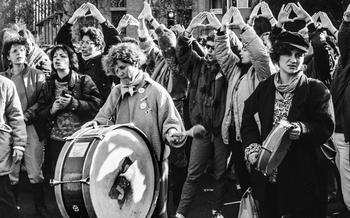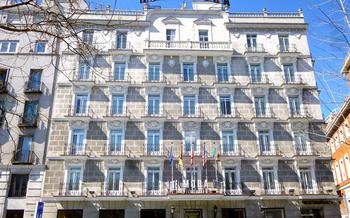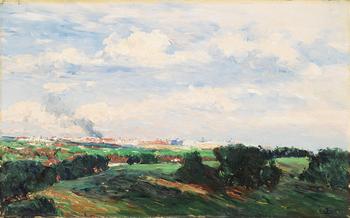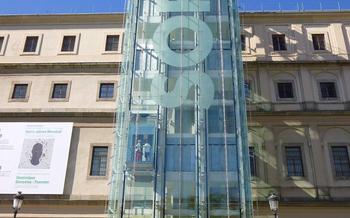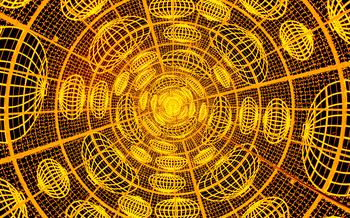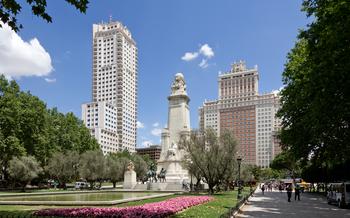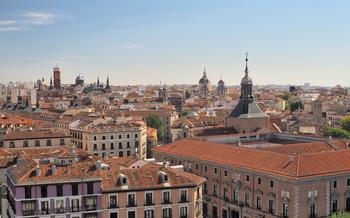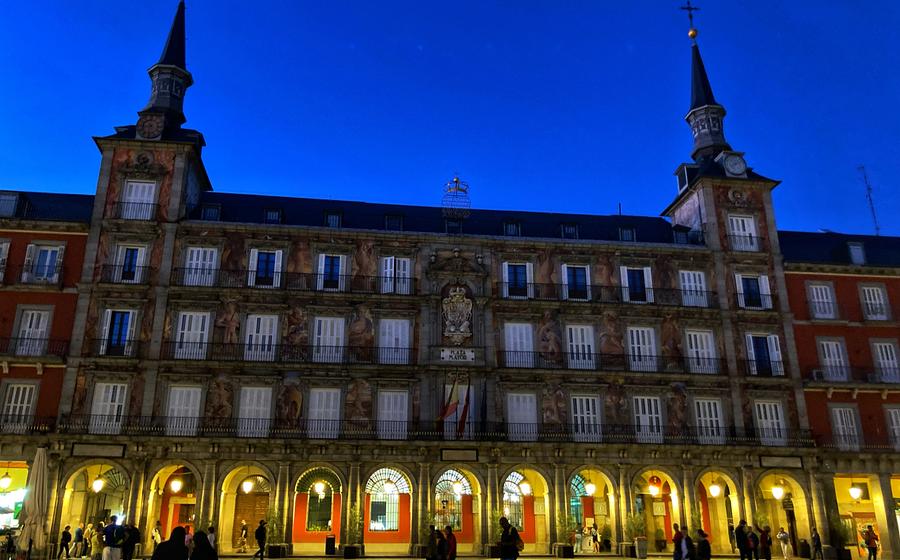
Casa de la Panadería
- Historical Significance
- Architectural Marvel
- Location and Accessibility
- Exhibitions and Events
- Guided Tours
- Photography and Videography
- Souvenirs and Gifts
- Accessibility for Visitors with Disabilities
- Food and Beverage Options
- Nearby Attractions:
- Historical Context
- Cultural Significance
- Restoration and Preservation Efforts
- Insider Tip:
Historical Significance
The Casa de la Panadería, a majestic landmark in the heart of Madrid, Spain, holds a rich tapestry of history dating back to the 17th century. Initially serving as a bakery, it symbolized the importance of bread in the daily lives of Madrid's citizens. Over time, the building evolved into a prominent landmark, witnessing significant historical events that shaped the city and the nation. Its architectural grandeur and historical significance earned it the prestigious status of a UNESCO World Heritage Site, recognizing its exceptional cultural value.
Throughout the centuries, the Casa de la Panadería has been associated with notable figures and events. It served as the residence of the city's bakers' guild, who played a crucial role in ensuring a steady supply of bread to the growing population. The building's facade bears witness to its transformation, adorned with beautiful frescoes depicting scenes from Madrid's history. These murals narrate tales of royal processions, market days, and religious festivals, offering a glimpse into the vibrant life of the city during different eras.
One of the most intriguing anecdotes associated with the Casa de la Panadería involves a daring escape during the Spanish Inquisition. Legend has it that a young woman, falsely accused of heresy, was imprisoned within the building's walls. With the help of a sympathetic guard, she managed to escape through a secret passageway, which is said to be hidden behind one of the ornate frescoes. This tale adds an air of mystery and intrigue to the Casa de la Panadería's already rich history.
Architectural Marvel
The Casa de la Panadería is a testament to the grandeur of Renaissance-style architecture, showcasing intricate details that captivate the eyes of visitors. Its facade is adorned with stunning frescoes that depict scenes from Spanish history and mythology, adding a touch of vibrancy to the building's exterior. The sculptures that adorn the facade, each intricately crafted with precision, contribute to the overall grandeur of the Casa de la Panadería, making it a masterpiece of architectural art.
The unique tower of the Casa de la Panadería is a defining feature that sets it apart from other buildings in Madrid. Rising high above the rest of the structure, the tower adds a touch of elegance and majesty to the building. It serves as a reminder of the building's historical significance and has become an iconic landmark in the city skyline.
The Casa de la Panadería has undergone several restoration efforts over the years, ensuring that its architectural integrity and beauty are preserved for future generations. These efforts have focused on maintaining the original design and materials, while also incorporating modern techniques to ensure the building's stability and longevity. As a result, visitors can still admire the Casa de la Panadería in all its glory, just as it was when it was first constructed centuries ago.
Location and Accessibility
The Casa de la Panadería is situated in the heart of Madrid, on the bustling Plaza Mayor, next to the iconic Arco de Cuchilleros. It is conveniently accessible by public transportation, with several metro stations nearby, including Sol and Ópera. Visitors can also opt to explore the area on foot, as the Casa de la Panadería is located within easy walking distance of many other notable attractions in Madrid.
The Casa de la Panadería is fully accessible to visitors with disabilities. A ramp at the entrance allows for easy access to the building, and there is an elevator that provides access to all floors. Accessible restrooms are also available on-site. Visitors with specific needs can request assistance from the staff, who are always willing to accommodate and ensure a comfortable and enjoyable visit for everyone.
To avoid the crowds and experience a more relaxed visit, it is recommended to visit the Casa de la Panadería early in the morning or during the off-season. The building is typically open to the public from Tuesday to Sunday, with extended hours on weekends. Visitors are advised to check the official website or call ahead to confirm the operating hours before their visit.
Exhibitions and Events
Throughout the year, the Casa de la Panadería hosts a variety of exhibitions and events that showcase the rich history and culture of Madrid. These exhibitions often delve into different aspects of the building's past, showcasing historical artifacts, documents, and artwork related to its evolution from a bakery to a prominent landmark. Visitors can also expect to find rotating art exhibitions featuring the works of local and international artists, as well as cultural events such as concerts, lectures, and workshops.
One of the most popular events held at the Casa de la Panadería is the annual "Madrid Medieval Market." During this event, the building's surroundings are transformed into a bustling medieval marketplace, complete with traditional costumes, food stalls, and craft demonstrations. Visitors can immerse themselves in the sights, sounds, and smells of medieval Madrid, experiencing the city's rich history firsthand.
To find out about upcoming exhibitions and events, visitors can check the Casa de la Panadería's website or social media pages. It's worth noting that some events may require advance registration or tickets, so it's advisable to plan ahead to avoid disappointment.
Guided Tours
Enhance your visit to the Casa de la Panadería by taking advantage of the guided tours offered. These tours provide an in-depth exploration of the building's history, architecture, and cultural significance. Led by knowledgeable guides, you'll gain insights into the stories behind the Casa de la Panadería and its place in Madrid's rich tapestry.
General Admission Tours: Embark on a comprehensive journey through the Casa de la Panadería's main highlights. Learn about its evolution from a humble bakery to a prominent landmark, and discover the fascinating tales associated with its past.
Specialized Tours: Delve deeper into specific aspects of the Casa de la Panadería's history and architecture. Choose from specialized tours focusing on its Renaissance-style facade, its role in significant historical events, or the restoration efforts that have preserved its grandeur.
Private Tours: For a more personalized experience, opt for a private tour tailored to your interests. Whether you're a history buff, an architecture enthusiast, or simply curious about the building's stories, your guide will craft an itinerary that caters to your unique preferences.
To book a guided tour, visit the Casa de la Panadería's official website or inquire at the ticket counter. Tours are available in various languages and at different times throughout the day. Secure your spot in advance to avoid disappointment, especially during peak tourist seasons.
Photography and Videography
Photography and videography are allowed inside the Casa de la Panadería, but there are some restrictions to ensure the preservation of the building and the comfort of other visitors. Flash photography and tripods are not permitted, as they can damage the delicate frescoes and sculptures. Natural light is usually sufficient for taking photos, but visitors may bring a small, handheld light source if necessary. Taking videos for personal use is generally allowed, but commercial filming requires prior permission from the authorities. It's important to be respectful of other visitors and avoid blocking their views or causing any disturbances while taking photos or videos. The Casa de la Panadería's stunning architecture and intricate details provide ample opportunities for capturing beautiful and memorable shots, so be sure to bring your camera or smartphone to document your visit.
Souvenirs and Gifts
At the Casa de la Panadería, visitors will find a delightful gift shop that offers a treasure trove of souvenirs and gifts to commemorate their visit. From beautifully illustrated books and postcards to replicas of historical artifacts and locally-made crafts, there is something for every taste and budget. These unique and memorable items not only serve as a lasting reminder of the Casa de la Panadería but also contribute to the preservation and maintenance of this iconic landmark. Whether you're looking for a gift for a loved one or a special memento for yourself, the gift shop at the Casa de la Panadería is sure to have something that catches your eye.
One of the most popular souvenirs is a replica of the Casa de la Panadería itself, a miniature version of the building that can be displayed on a shelf or desk. Another popular item is a set of postcards featuring stunning photographs of the building's exterior and interior. For those interested in learning more about the history of the Casa de la Panadería, there are several books available that delve into its rich past and significance. And for those who love to cook, there is a cookbook featuring recipes inspired by the building's history as a bakery.
The proceeds from the gift shop play a vital role in supporting the ongoing restoration and preservation efforts of the Casa de la Panadería. By purchasing a souvenir or gift, visitors are not only taking home a piece of history but also contributing to the preservation of this beloved landmark for future generations.
Accessibility for Visitors with Disabilities
The Casa de la Panadería is committed to ensuring that all visitors have a comfortable and enjoyable experience, regardless of their abilities. The building is equipped with several accessibility features that make it easy for visitors with disabilities to navigate and explore the premises.
Ramps are available at all entrances to the Casa de la Panadería, allowing wheelchair users and visitors with limited mobility to enter and exit the building without difficulty. Inside, accessible restrooms are located on each floor, providing a convenient and private space for visitors with disabilities.
Additionally, the Casa de la Panadería offers assistive listening devices for visitors who are hard of hearing. These devices can be used during guided tours or presentations to ensure that everyone can fully participate and enjoy the experience.
For visitors with visual impairments, the Casa de la Panadería provides tactile maps and models of the building to help them understand the layout and explore the exhibits. Braille signage is also available throughout the building, providing essential information for visitors who are blind or have low vision.
With these accessibility features in place, the Casa de la Panadería welcomes visitors with disabilities to explore its rich history and stunning architecture without barriers.
Food and Beverage Options
While the Casa de la Panadería does not have its own café or restaurant, visitors can find a variety of dining options within a short walk. The surrounding area is home to numerous cafes, restaurants, and snack bars that cater to different tastes and budgets.
For a quick bite, visitors can grab a sandwich or pastry at one of the many bakeries or cafes in the area. For a more substantial meal, there are several restaurants that offer traditional Spanish cuisine, as well as international dishes.
One popular option is the Mercado de San Miguel, a bustling indoor market located just a few steps from the Casa de la Panadería. The market is home to over 30 food stalls, offering a wide variety of tapas, pintxos, and other Spanish delicacies. Visitors can sample different dishes from various regions of Spain, all under one roof.
Another nearby option is the Calle Cava Baja, a charming street known for its lively tapas bars. Visitors can hop from bar to bar, sampling different tapas and drinks while enjoying the vibrant atmosphere.
Whether you are looking for a quick snack or a leisurely meal, you are sure to find something to your taste in the vicinity of the Casa de la Panadería.
Nearby Attractions:
The Casa de la Panadería is surrounded by a wealth of other attractions that visitors can explore before or after their visit. Just a short walk away is the Plaza Mayor, one of Madrid's most iconic squares, known for its lively atmosphere and beautiful architecture. Visitors can also visit the nearby San Miguel Market, a vibrant indoor market with a wide variety of food and drink stalls, or take a stroll through the narrow streets of the La Latina neighborhood, with its charming boutiques and tapas bars. For art enthusiasts, the Reina Sofía Museum is just a short walk away, showcasing a collection of modern and contemporary Spanish art, including works by Picasso, Dalí, and Miró. The Royal Palace of Madrid, the official residence of the Spanish royal family, is also located nearby and offers visitors a glimpse into the history and grandeur of the Spanish monarchy.
Historical Context
The Casa de la Panadería stands as a testament to Madrid's rich and storied past. Originally constructed in the 16th century, it served as a bakery that supplied bread to the royal family and the city's elite. Over the centuries, the building witnessed numerous historical events that shaped the course of Madrid's development.
During the reign of the Habsburg dynasty, the Casa de la Panadería played a crucial role in the Spanish Inquisition. It served as a meeting place for the Inquisition's tribunals, where accused heretics were interrogated and tried. The building's walls hold silent witness to the harrowing tales of those who faced persecution during this dark period of Spanish history.
In the early 19th century, the Casa de la Panadería became a focal point of resistance during the Peninsular War against Napoleon's invading forces. The building was used as a headquarters by Spanish guerrilla fighters, who coordinated their efforts to liberate the city from French occupation.
Throughout its existence, the Casa de la Panadería has been home to a variety of notable figures who contributed to Spanish history and culture. Among them was Lope de Vega, one of the most celebrated playwrights of the Spanish Golden Age, who lived in the building during the 17th century. His literary genius left an enduring mark on Spanish literature, and his works continue to be performed and studied to this day.
The Casa de la Panadería's historical significance extends beyond its role in specific events and the people who inhabited it. The building itself is a tangible representation of Madrid's transformation from a small medieval town to a vibrant and cosmopolitan capital city. Its enduring presence serves as a reminder of the city's resilience and its ability to adapt to the changing tides of history.
Cultural Significance
The Casa de la Panadería holds a profound cultural significance for the city of Madrid and Spain as a whole. It stands as a testament to the country's rich history, artistic achievements, and cultural identity. The building's unique architectural style, intricate frescoes, and historical associations make it a symbol of Spanish heritage and pride.
Over the centuries, the Casa de la Panadería has played a vital role in promoting and preserving Spanish culture and traditions. It has served as a venue for numerous cultural events, exhibitions, and festivals that celebrate Spanish art, music, dance, and literature. These events attract both locals and tourists alike, fostering a sense of community and cultural exchange.
One of the most notable cultural events held at the Casa de la Panadería is the annual "Madrid de los Austrias" festival. This festival brings the city's rich history to life with reenactments of historical scenes, traditional music and dance performances, and artisan demonstrations. Visitors can immerse themselves in the vibrant atmosphere and experience the cultural heritage of Madrid firsthand.
Restoration and Preservation Efforts
The Casa de la Panadería has undergone several restoration and preservation efforts throughout its history to maintain its historical integrity and architectural splendor. One of the most significant restoration projects was undertaken in the 1990s, which involved meticulous cleaning and repair of the building's facade, as well as the restoration of its intricate frescoes and sculptures.
A team of skilled craftsmen and conservators worked tirelessly to restore the building to its former glory, using traditional techniques and materials to ensure authenticity. The restoration project was a testament to the dedication and expertise of the professionals involved, and it has helped to preserve this iconic landmark for future generations.
Other preservation efforts have focused on maintaining the structural integrity of the building, including reinforcing its foundations and repairing any damage caused by natural elements or the passage of time. Organizations such as the Spanish government and the Madrid City Council have played a crucial role in providing funding and support for these restoration and preservation projects.
The Casa de la Panadería stands as a testament to the importance of preserving our architectural heritage. The restoration and preservation efforts that have been undertaken have ensured that this iconic landmark will continue to grace the Plaza Mayor for many years to come.
Insider Tip:
One of the hidden gems of the Casa de la Panadería is its stunning rooftop terrace, which offers breathtaking views of the city of Madrid. While it's not always open to the public, there are certain times of the year when guided tours are offered that include access to the terrace. If you're lucky enough to get the chance to visit the terrace, be sure to take your time to soak in the panoramic views and capture some unforgettable photos. It's an experience that will leave you with lasting memories of your time in Madrid.
